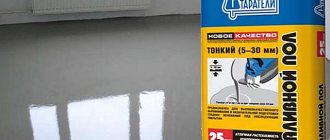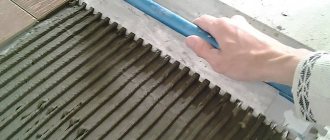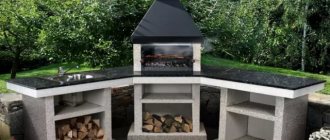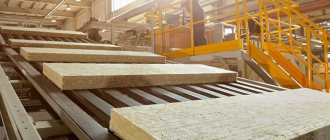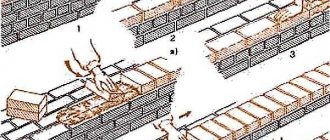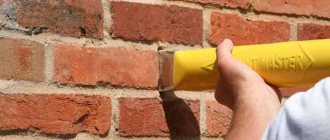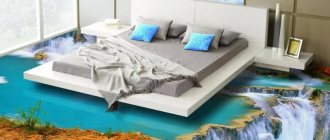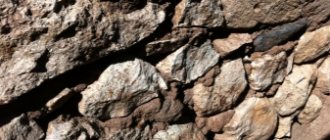The strength of the structure as a whole depends on the quality of the glue used for laying expanded clay concrete blocks.
After all, it is this binding composition that is responsible for the adhesion of building elements to each other.
Therefore, it is so important to know what glue is used for laying expanded clay concrete blocks, what is included in its composition, what its pros and cons are, and how to use it correctly. Read about this and more in the article.
Technology of applying plaster composition to expanded clay concrete blocks
External and internal application of plaster composition to expanded clay concrete blocks can only be carried out if you have the appropriate experience.
To begin with, the surface is prepared, which involves not only removing defects, but also applying a primer. The most important stage is plastering. The solution, if necessary, must be prepared and pigmented
If special equipment is available, mechanized plastering can be performed. With the help of such installations, the solution is mixed without the involvement of a person and quite quickly.
Preparing the wall surface
Expanded clay blocks must be prepared before applying facade plaster to the walls of the house. To do this, all dirt is removed from the blocks, as well as oil stains, as well as everything that can reduce grip. A positive quality is that the layer of plaster mortar will practically not be absorbed into expanded clay concrete blocks, which have low water absorption.
As a preparatory layer, you can combine water with cement to create a solution that is applied before the main layer of plaster. This is true if the finishing is carried out on the basis of cement and sand. Expanded clay concrete masonry turns out to be quite smooth, so a layer of the mixture is poured in such a way as to form no more than 1.5 cm. If the work was not carried out by professionals, then the laying may have some defects, then the consumption of plaster will increase.
Preparation of plaster mortar and its application
If the solution was purchased in dry form, it will need to be combined with water and color added if necessary. Mixing in this case is carried out using a drill, which is turned on at low speed. When the solution is purchased ready-made, it can be applied immediately. Laying should be done with a trowel, and leveling should be done using a rule. To make this possible, beacons are pre-installed. 6 hours after applying the first layer, rub it well, and then begin applying the finishing layer.
Nuances of the work
If the house is not new, then its external walls also need to be freed from old finishing, even if it seems suitable for plastering. Sealing of cracks and seams is carried out flush with the surface. You can also use a ready-made solution for this. Sometimes you buy putty intended for seams. After preparing the laitance for the first layer of primer, the composition must be applied to the surface with a brush. You need to move it horizontally, which will increase adhesion between the layers.
Then you can start filling the mesh. If it is not there, you can replace the layer with staples. An alternative is metal anchors with washers. When placing beacons, you need to make sure that their position is level. In this case, you need to use a level or plumb line. A distance of 1.5 m is left between these elements, which will allow you to conveniently work with the 2 m rule.
When preparing the mixture yourself, you need to carry out this work using a wide tray. If you don’t have a mixer, you can use a spatula to bring the mixture to the consistency of liquid puree.
The solution can be poured onto the base with a ladle, and smoothing is carried out from the bottom up. The rule is to move not only down, but also left and right. The final layer is applied using a trowel. You need to try to fill all the depressions with the mixture. As soon as this layer has set, you need to grout it with a float, which the master moves at a run or in a circle. Once the plaster has dried, it needs to be primed or painted. Sometimes the surface is covered with any finishing, it can be decorative putty.
Mechanized block plastering
If you decide to decorate your home outside or inside using special equipment, you will receive many advantages. Firstly, the composition can be mixed in a short time, without using buckets and mixers. Secondly, it’s much easier to do this, and you won’t waste any effort. Thirdly, application can be done in an even layer; the machine will do almost everything for you.
The solution adheres well to the surface, and the layer is more durable, because it is supplied under pressure. Less building materials are consumed and labor costs are reduced. If you decide to use the device, you should select a special dry mixture. By finishing the interior walls in this way, you will be able to use any finishing materials for subsequent interior finishing.
Features of the construction of external and internal walls
When constructing lightweight concrete structures, the following should be taken into account:
- the solution should be applied in a thin layer;
- the prepared mixture should have a thick consistency to minimize the risk of shrinkage;
- for high-quality adhesion of the panels to each other, they must be pre-moistened;
- wood concrete blocks must fit tightly to each other;
- the solution should evenly fill the gaps between the panels;
- the resulting excess glue is leveled using a celt, leveling the mixture lengthwise towards the previous block;
- To increase the strength of structural elements, an adhesive solution is additionally applied and distributed along the seams.
During the laying process, it is necessary to ensure that the joints of the external and internal walls form a right angle.
How to calculate consumption?
Mixture consumption is calculated in dry form. The volume depends on the size of the elements from which the wall is built:
- For blocks measuring 51x25x21.9 cm - 33 kg/m2 or 65 kg/m3 or 2 kg/piece.
- For blocks measuring 44x25x21.9 cm - 29 kg/m2 or 65 kg/m3 or 1.7 kg/piece.
- For blocks measuring 38x25x21.9 cm - 26 kg/m2 or 65 kg/m3 or 1.6 kg/piece.
- For blocks measuring 25x25x21.9 cm - 20 kg/m2 or 65 kg/m3 or 1.2 kg/piece.
For example, for an interior partition with a width of 12 cm, the masonry will be done in 1/2 blocks. It turns out that for a volume of 51x12x21.9 cm you will need to divide the initial consumption figures by 2, that is, 16 kg/m2 or 65 kg/m3 (always the same) or 1 kg/piece.
What does consumption depend on?
Preparing a solution for a specific task requires compliance with proportions and the “correct” mixing technology. The proportions differ even for heavy concrete of different brands, not to mention plaster or masonry mortar.
At the same time, knowing the reference proportions is not enough - you need to understand the principles of mixing, their dependence on the characteristics of the individual components.
Main factors affecting consumption
First of all, consumption depends on the strength (grade) of concrete or mortar. The brand is chosen based on the type of work planned.
Knowing the brand of concrete and available raw materials, you can determine the required proportions using reference tables.
The table shows that the proportions of the mixture for concrete M100 for Portland cement M500 are 1: 5.8: 8.1, and for concrete M300 – 1: 2.4: 4.3. Accordingly, the stronger the concrete mixture, the higher the cement consumption rate.
In addition to the concrete grade, cement consumption is affected by:
- brand of cement - from the table above it can be seen that M500 uses less per cubic meter of solution than M400. Moreover, the stronger the binder, the higher the grade of concrete. However, in reality, the quality and type of aggregate also influences the “output” strength;
- actual strength - after 3 months of storage, the binder can lose up to a fifth of its brand strength;
- amount of filler - the cement “dough” should completely envelop the particles of sand and crushed stone. If there is too little “dough”, the mixture will not be homogeneous. Therefore, in practice, mixing M100–M200 concrete from the M500 binder is not entirely advisable;
- quality of the aggregate - the presence of dust, organic dirt, clay (for sand) or flaky grains (for crushed stone) will lead to an increase in binder consumption to compensate for the loss of strength of the mixture.
Brand of concrete for the foundation
Conclusion: consumption primarily depends on the design strength of the concrete (mortar). You should also not ignore the actual strength of the binder and the quality of the aggregates.
Application technique
The special masonry mixture for aerated concrete blocks is quite easy to work with. The entire procedure is divided into several main stages; the technology must be followed carefully, which will ensure high quality masonry and allow you to experience all the advantages of the material.
The main stages of working with assembly adhesive:
- Proper preparation of the base - the surface must be dry, free of dirt and dust, any stains of oil or other substances. All roughness and defects are removed, the surface can be leveled with a solution at least a day before starting work with assembly adhesive for cellular concrete.
- Preparing the glue for use - the dry composition is diluted with warm water in a ratio of 1:5 (water and glue, respectively), stirred thoroughly to remove lumps. Allow the glue to stand for 5 minutes, then gently mix again. The finished composition for laying blocks is used within 2 hours after mixing.
- Direct installation of cellular blocks - the solution is placed on the surface with a special box or spatula, leveled with a notched trowel. The blocks are glued with slight pressure; the connection will acquire sufficient strength within 20 minutes, so the position of the block must be corrected and leveled in the first 10 minutes after laying. Complete hardening occurs after different times depending on the composition of the specific adhesive, the level of humidity and temperature in the room, and the thickness of the layer, but is usually completed within 24 hours.
How to calculate consumption?
In order to understand exactly how much money will be spent on the adhesive solution, you need to calculate its consumption. Often the material consumption is indicated on the glue packaging, but craftsmen note that such consumption is sometimes not enough. It's best to do the calculations yourself. To do this you need:
- find out the dimensions of 1 gas silicate block;
- find out the thickness of the seam that will be used during laying;
- find out the surface area;
- choose glue.
The standard size of gas silicate for masonry walls is taken as a basis: 600x300x200 mm. To lay 1 square meter of gas silicate blocks with a seam thickness of 10 mm, you will need 10 kg of glue solution.
At the same time, the bags are produced in 20-25 kg sizes, which means that approximately half a bag is needed for a given laying.
For accuracy of calculations, you can consider the total size of the masonry. For example, the wall area will be 12 squares. This means that for its laying with a seam thickness of 15 mm, 180 kg of adhesive solution will be required. In dry form it is 7.2 bags of glue, 25 kg each.
Types of glue for laying blocks (review of manufacturers)
An impressive range of building blocks of various types contributes to the fact that manufacturers produce a large number of adhesive compositions for the construction of block structures. The main advantage of using glue is the simple process of preparing the mixture, high adhesion and quick drying of interblock joints. You need to choose a product depending on the type of blocks and installation features.
All adhesives are based on a cement-sand mixture with the inclusion of polymer plasticizers, modifiers, and additives. These components give the finished solution moisture-resistant, elastic, and strength characteristics. The cost of the mixtures is quite affordable; the adhesives are packaged in 25 kg packages. To lay three dozen standard gas or foam materials, you need to spend one bag of dry glue for concrete blocks. For each type of construction product, adhesive mixtures with certain characteristics are produced.
For foam blocks
Lightweight foam blocks have a pronounced porous structure. To firmly glue materials together, special adhesives are used, the composition of which differs from the bulk cement-sand mixture. Finely dispersed quartz sand is added to the adhesive mass. Features and advantages of mixtures for foam blocks:
- Increased moisture resistance of block masonry and rapid increase in strength of the mixture.
- Minimum layer thickness due to the absence of coarse components.
- Prevents the formation of mold fungi, high elasticity of the mixture.
The plasticity of adhesives for laying foam blocks reduces the likelihood of ruptures and deformations of interblock seams. Cracks and crevices do not form in the bonding layer, and distortion of the foam blocks in the erected structure does not occur. If you use winter adhesives, you can carry out installation work at negative air temperatures (up to -15 degrees). Foam blocks are laid on high-quality adhesives given in Table 1.
Table 1. Popular brands of glue for foam blocks
| Brand Properties | Founds Selform | Volma | Kreps | Knauf | Ceresit CT 21 | Ytong |
| Weight, kg | 25 | 25 | 25 | 30 | 25 | 25 |
| Consumption, kg/m2 | 1,3 | 1,4 | 1,6 | 4.5 layer 2-3 mm | 1,3 | 1,5-1,6 |
| Lifetime | 3 hours | 2.5 hours | 4 hours | 3 hours | 2 hours | 2-3 hours |
| Editing seams | 15 minutes | 15 minutes | 10-12 minutes | 10 minutes | 20 minutes | 15 minutes |
| The cycles are frozen. | 75 | From 35 | From 35 | From 35 | From 35 | From 35 |
The cost of products varies from 180 to 240 rubles, depending on the characteristics of the composition. Mounting adhesive Osnovit Selform MS-112 is widely popular. According to the characteristics declared by the manufacturer, the composition can withstand 75 freezing/unfreezing cycles, which indicates a long service life of the composition and its high strength. Products from the Aeroc and Praktik Bergauf brands (winter and summer options for foam blocks) have good adhesive properties.
The high-quality adhesive Starateli for foam and gas blocks, as well as cellular concrete with light aggregates, is in great demand among buyers. The plastic structure of the composition allows the formation of thin seams, which reduces the likelihood of the formation of cold bridges in block masonry. The approximate consumption of dry mixture is 2 bags per cubic meter of wall.
Advice! You need to prepare the mixture in such quantity that you have time to develop the composition in 2-3 hours. After the pot life expires, the glue begins to thicken, acquires high viscosity and loses its original properties. You cannot add water to the solution to dilute the mixture - this will not help correct the situation.
For ceramic blocks
The popularity of building houses from ceramic blocks is growing every day. The material has good characteristics - low thermal conductivity, hollowness, natural components. For ceramic blocks, glue is selected with a special composition. It is recommended to make 2 mm thick seams between blocks of baked clay.
The properties of the adhesive for ceramic blocks are identical to the material itself, which allows you to successfully form a uniform thermal insulation plane. The adhesives are based on a cement-sand mixture, into which imported plasticizers from organic or mineral raw materials are introduced to impart water-repellent properties to the composition. The following adhesive is suitable for installing warm ceramics:
- Promix TKS 201 manufactured by PEREL is a composition based on mineral additives with a reduced thermal conductivity coefficient. Withstands 50 freezing-unfreezing cycles, average mixture consumption is 1.2-2.7 kg/m2, packaging – 25 kg bags.
2. Dauer Thermofix 20 – frost-resistant, moisture-resistant adhesive for ceramic blocks, with high resistance to deformation and tearing. The adhesive contains high-quality Portland cement, mineral fillers and polymer additives. The imported product is packaged in 20 kg bags.
3. Wienerberger POROTHERM TM masonry mixture is a special adhesive with low thermal conductivity, suitable for laying warm ceramics, eliminating the formation of cold bridges. The minimum frost resistance of the adhesive is 50 cycles. You can buy glue in 20 kg packages.
4. Teploshov adhesive from the manufacturer DeLuxe - intended for the construction of partitions and walls of a universal type, including masonry made of ceramic blocks. The average consumption of the mixture is 1.2 kg/m2 - economical spending. The component composition includes foam glass granules and a complex of modified additives. Packaging – 20 kg.
The Promix TKS line of masonry mixtures includes several products for the installation of ceramic building materials. The compositions have low thermal conductivity, high strength and resistance to dynamic loads. The cement mixture includes polymers and light mineral fillers.
On a note! For laying ceramic blocks, you can use Perfekta Linker Thermo adhesive with an internal reinforcement system to reduce the settlement of the mortar in the interblock joints. For porous ceramics, a mixture of Kreisel DAMMORTEL 120 is suitable - a hydrophobized adhesive based on mineral binders, as well as a high-quality product Braer LM21 with pronounced thermal insulation characteristics.
On video: Masonry mixture for ceramic blocks.
For polystyrene concrete blocks
Polystyrene concrete belongs to the category of light cellular materials with the inclusion of mineral components. Therefore, for their installation it is rational to use adhesive mixtures of Portland cement and small granules of foamed polystyrene. As a result of processing, the erected walls acquire good hydrophobicity and high resistance to loads and deformations. Mix the mixture with water in the proportion indicated on the package. What adhesives are suitable for installing polystyrene concrete materials:
- Bolars block glue is a frost-resistant winter mastic that can be used at temperatures down to -10 degrees. It has increased resistance to compression and can withstand 50 freezing cycles. Seams can be applied with a thickness of 2-8 mm, depending on the porosity of the blocks. The masonry adjustment time is 10 minutes.
- The Keraflex mounting composition is a universal mixture, excellent for the construction of walls made of polystyrene concrete. The lifetime of the finished solution is 3 hours, and you can “correct” the masonry in 5-7 minutes. The main advantages are a high level of frost resistance, good strength, layer thickness 2-10 mm.
- The effective Betonkol mixture for lightweight concrete demonstrates very high frost resistance (200 cycles) and excellent peel strength. To obtain high-quality masonry, it is recommended to apply a layer of 2-5 mm. The finished solution remains viable for a long time; the masonry can be adjusted in no more than 5 minutes.
- Polystyrene G-32 has similar characteristics to Betonkol. The main advantages are water resistance, biological and atmospheric resistance. Frost resistance level – 200 cycles. The manufacturer recommends applying a layer of 2-8 mm; defects in the masonry can be corrected in no more than 10 minutes.
- “Blok” glue is a high-quality, frost-resistant, waterproof composition. Has good tear and compression properties. The lifetime of the adhesive mass is 3 hours, leaving 7 minutes for masonry correction. Glue belongs to the category of universal mixtures.
It is necessary to pay attention that products from different manufacturers intended for the installation of polystyrene concrete differ in individual properties. For example, one glue has high strength, the second has ductility, and the third has durability. This point must be taken into account when choosing a specific composition.
Attention! Among builders, there is an opinion that polystyrene concrete blocks can be laid with tile adhesive. This is strictly not recommended, since tile compositions do not have the required characteristics. As a result, the physical and mechanical properties of the erected structure are violated.
For gas silicate blocks
Manufacturers produce the largest range of adhesive products for the installation of gas blocks. Prices for dry mixtures vary widely; the cost of the compositions depends on brand recognition and product quality. Gas silicate blocks are placed on adhesives that are resistant to precipitation, have high strength and resistance to low temperatures:
- Zabudov's glue for gas silicate blocks is a winter solution, suitable for construction at low temperatures. If you lay a composition with a thickness of 3 mm, then 28 kg are required per 1 sq.m3 of masonry. The dry composition is packaged in 25 kg bags. The use of glue for Zabudov blocks allows you to apply uniform, strong seams.
2. The composition of Prestige has high frost resistance and elasticity. These qualities are imparted to the glue by mineral plasticizers and imported additives included in the cement-sand base. The average consumption of the finished mixture is 5-6 kg/m2, if the solution is applied with a thickness of 5 mm.
3. Uniblock adhesive has good technical characteristics and thermal insulation properties, thanks to the inclusion of chemical additives and mineral filler. The advantages of the mixture are resistance to moisture and negative temperatures. With a layer of 5 mm, 3.5-4.5 kg of glue per 1 m2 is required.
4. Summer composition Insi has high water-repellent characteristics. Quartz sand, polymers and mineral additives are introduced into the cement base, which increase the strength of the mixture. When applying a 2-4 mm layer, 28 kg of mixture per 1 m3 is required. The composition is high quality and inexpensive.
5. Adhesive for gas silicate blocks Etalon Teplit is produced in summer and winter versions. Due to modified additives and mineral filler, the adhesive mass acquires hydrophobic properties and resistance to deformation and chemical influences. The approximate consumption of the mixture is 1.4 kg/m2 when applying a layer of 1 mm.
YTONG adhesive for aerated concrete deserves special attention, which is supplied to the market in two versions - Economy and Winter. The composition reduces the thermal conductivity of the masonry and improves the water resistance of the monolithic structure. Yutong glue for the block has a minimum consumption per 1 m3 - 18-20 kg of mixture with a 2-3 mm thickness of the applied layer.
Important! Frost-resistant adhesives for gas silicate blocks include modifying additives that allow installation of walls at sub-zero temperatures down to -15-25°C.
Universal glue
A wide range of applications and compatibility with blocks of various structures are the main features of universal adhesives. Such mixtures can be used for the installation of expanded clay concrete, ceramic blocks, and polystyrene concrete. The most popular brands of universal glue:
- Adhesive for Knauf blocks - reduces the hygroscopic properties of porous materials, suitable for foam and gas blocks. It is characterized by increased adhesion, minimal consumption and low thermal conductivity. It is characterized by ease of use, easy application and a high degree of adhesion to the base.
- AXTON assembly cement adhesive for gas blocks is suitable for working with gas silicates, foam silicates, aerated concrete, foam concrete, foam concrete, polystyrene concrete. The main advantages of the material are weather resistance, economical consumption, and high ductility.
- A universal product for laying any type of cellular concrete is ilmax 2000 adhesive for blocks. With its help, seams with a thickness of 2-5 mm are formed using a trowel and a notched trowel. Adhesive for ilmax 2000 blocks is characterized by economical consumption and good self-filling of deformed areas of masonry - chips, irregularities and potholes.
- Adhesive for thin joint masonry Weber Betonit Blok glues cellular concrete and tongue-and-groove blocks well. The formed seams do not crack and do not freeze in the cold. One of the advantages of the solution is its high water-holding capacity. The product is made from environmentally friendly components.
There are a lot of universal compositions, but experienced craftsmen recommend using certain adhesives for specific types of blocks.
Attention! To prepare a solution from a dry mixture, first pour water into a container in the volume indicated on the packaging, and then gradually add adhesive powder into it.
Difficulties and mistakes
Laying walls yourself is never without problems. But if you foresee possible difficulties in advance, you can facilitate the construction process and avoid gross violations in the masonry.
Typical mistakes that should not be made:
- Installation of low-quality products.
Products must be certified, and the composition cannot contain any low-quality additives or slag impurities. Manufacturers that respect themselves and their reputation add only clean, sifted quarry sand, clean water, high-grade cement and good quality expanded clay. Therefore, when buying a product from unknown companies or not paying attention to its accompanying documents, you can run into an outright fake. - Use of defective products. The blocks should not have chips, damage or gouges that would affect its structural integrity and durability. If a block has such damage and does not crumble in your hands, this does not mean that it will remain intact in the wall. The load can simply crack the product and lead to the destruction of an entire section of the wall.
- Splitting blocks with a pick or hammer. The blocks must be carefully cut with a grinder or a special hacksaw, but not beaten off. Firstly, there is no guarantee that the required piece will be cut off using this method. And secondly, you can hit too many, and as a result such a block cannot be used anywhere. And this is already an overconsumption of material.
- Purchase of blocks with low density. To build a residential building with one floor or a garage, it is enough to take blocks with a density of D. But for more elevated and serious buildings, the density should be even higher - at least D800 (800 kg/m3).
- Using reinforced concrete slabs as an armored belt. This material is too heavy for expanded clay concrete. The role of the armored belt is to help the walls evenly distribute the load from the floor beams and roof, and not to give them an even greater load from the weight of the armored belt.
Characteristics that a quality composition must have
In accordance with European quality standards, a reliable product must have the following properties:
- Maintains characteristics for 1-4 hours.
- The standard mixture should not be covered with a film for 20 minutes, quick-drying - 10 minutes.
- The permissible maximum surface slip after applying glue is half a millimeter; ideally, there should be no slip at all.
In order for buyers to be able to choose the most suitable composition for use in specific conditions and for a specific purpose, manufacturers mark their products with codes:
- G—liquid mixture;
- T - without creeping effect;
- F - fast-hardening agent;
- E - allowed to be kept open;
- C2S - resistant to deformation;
- C2 - composition with improved characteristics;
- C1 is a regular mixture.
Dimensions and materials for laying expanded clay concrete blocks
Expanded clay concrete block, like almost any building material, has its own standard dimensions. As a rule, for load-bearing walls the dimensions of an expanded clay concrete block in mm are 190 x 190 x 390. For internal partitions, the blocks are slightly narrower - 90 - 120 mm, otherwise the dimensions remain the same. Expanded clay concrete blocks are packaged on pallets, followed by bandaging, and delivered to the site, as a rule, by a manipulator. Some manufacturers sell blocks in bulk, but it must be taken into account that there will be a lot of scrap during unloading.
Unlike masonry walls made of gas silicate blocks, expanded clay concrete blocks are laid exclusively on ordinary mortar. Laying with glue will not work due to the porosity and heterogeneity of the block surface. There is no way a 2-5mm seam will work.
The technology for laying expanded clay concrete blocks is not much different from the technology for laying brick walls. The only difference is the rubber mallet (rubber hammer), which is used to level the block on the wall.
Since an expanded clay concrete block is usually hollow, any, even not very strong, blow with a metal hammer can break the block. Therefore, it is advisable to level the blocks on the wall with a rubber mallet.
Introduction to the topic
The widespread use and popularity of blocks is caused by the good technical and operational characteristics of cellular concrete materials. Brickwork is inferior to blocks because it requires a lot of time and puts a significant load on the foundation. The building blocks are large in size, but have minimal weight, so the installation speed increases significantly. Foam blocks and gas silicates can be installed on any type of foundation, including shallow foundations, and can be used to build low-rise buildings. The advantages of using building blocks are obvious:
- Minimum load of wall structures on the base.
- Prompt construction of residential buildings and other buildings.
- Economical consumption of adhesive solution for installation.
- High strength of buildings made of cellular (porous) concrete.
- Low thermal conductivity and vapor permeability of the material.
Adhesive for blocks fixes structural elements together as firmly as possible, thanks to the introduction of special components into the composition. Using adhesive compositions, monolithic load-bearing walls, interior partitions, and internal walls made of gas and foam concrete are erected. Lightweight building material is gradually replacing traditional buildings made of brick and wood.
On a note! The use of reinforcement belts between aerated concrete and foam blocks allows the construction of not only one-story buildings, but also houses with a height of two and three tiers.
Type of solutions used
The laying of expanded clay blocks is carried out using a mortar or special glue, and the consumption of binding components will be an order of magnitude less than when using ceramic bricks, since the volume of material is seven times greater than the volume of more conventional bricks.
The process of mixing the solution should not exceed three minutes, otherwise its original properties may be lost. You can add lime to it, but then it will have a more cellular structure and will allow you to use less solution. It is because of lime that the solution will become more susceptible to moisture and become less durable, which may lead to cracking of the walls.
There are several options for mortars for laying expanded clay concrete blocks:
- Cement-sand mixture.
- Powder ready-mixes.
To make a standard solution, you will need:
- fine-grained sand – 1 part;
- cement grade 400 or 500 - 3 parts;
- water, pre-purified and cooled - 1 part.
Procedure for preparing the solution:
- A small amount of water is poured into the concrete mixer.
- Concrete and sand are poured in the required proportions.
- During the kneading process, the remaining water is added.
Features of cement-sand mortars:
- prepare the solution immediately before use;
- it is not stored for future use;
- its hardening time is about 2 hours;
- To increase such an indicator as plasticity, you can use one of the many plasticizers.
As for ready-made dry mixtures, they are a powder that is mixed with water. Use a concrete mixer for this. Water is added only in the amount recommended according to the instructions. Such solutions require a longer time to harden. But their cost is quite impressive.
The best brands
The construction market offers products from many domestic and foreign manufacturers. According to reviews, concrete adhesive, which is considered one of the best, is produced by Ceresit.
Domestic brands are no less popular:
- "Leader";
- "Polymen";
- "Polyrem."
Demanded products from foreign manufacturers:
- Bostik;
- Findley;
- seder;
- Emfi;
- Knauf;
- Jovi.
Advice! The leading position as a mixture used for cellular concrete is occupied by the Monolith brand.
Consequences of technology violation
Due to broken reinforcement or an incorrect process, the following may occur:
- Cracks in the walls or collapses, which will then require you to spend your own time and incur additional costs for repairs.
- Incorrectly made frame, which can change the correct geometry of the walls.
- Curvature of wall masonry due to uneven distribution of load on the walls.
- The protruding parts of the reinforcement from the wall will protrude from the masonry and will not perform reinforcing functions.
If it is impossible to carry out work with reinforcing devices yourself, it is best to seek help from professionals.
Ceresit
High efficiency of glue application is achieved by adding a special plasticizer. The products of this brand are characterized by improved adhesive properties, minimal slipping of cladding elements and an affordable price. The glue is based on white cement.
"Ceresit 115" is recommended by the manufacturer for use at the following sites:
- old cladding;
- screeds outside the house with heating;
- outdoor swimming pools;
- roofs;
- floor on the balcony or terrace;
- stairs outside buildings.
